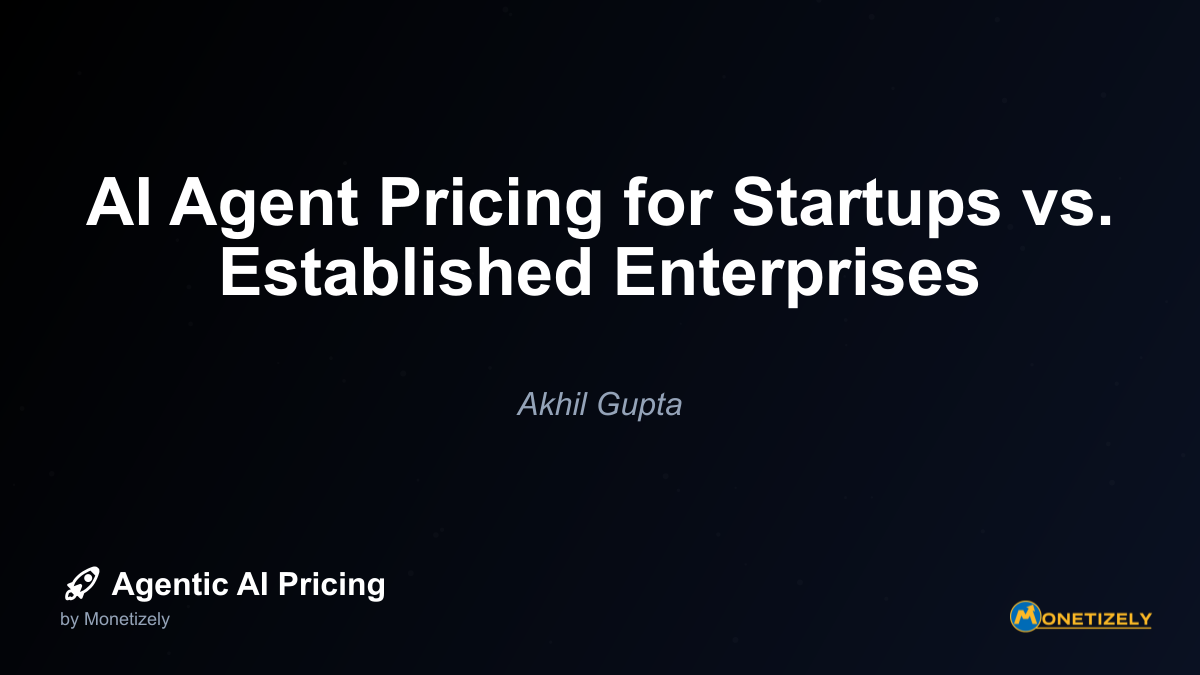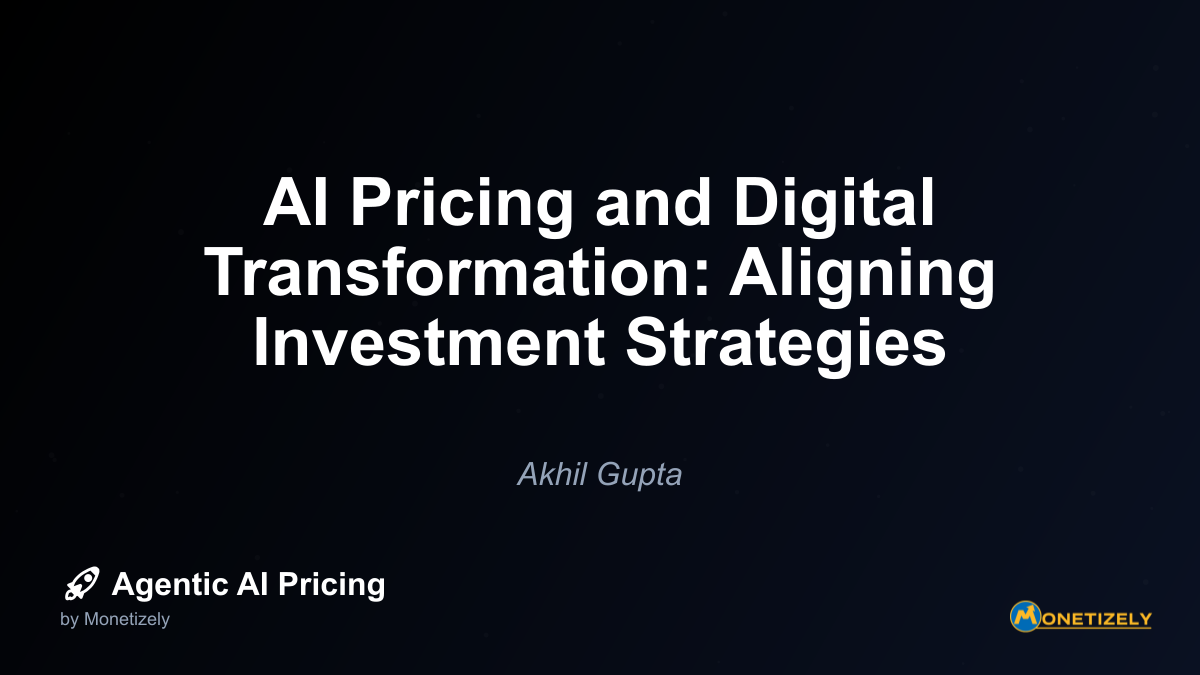· Akhil Gupta · Strategy · 12 min read
AI Pricing Models That Scale From SMB to Enterprise
AI and SaaS Pricing Masterclass
Learn the art of strategic pricing directly from industry experts. Our comprehensive course provides frameworks and methodologies for optimizing your pricing strategy in the evolving AI landscape. Earn a professional certification that can be imported directly to your LinkedIn profile.

The evolution of artificial intelligence has transformed business operations across industries, but a persistent challenge remains: how to design AI pricing models that effectively serve both small-to-medium businesses (SMBs) and large enterprises. These segments have fundamentally different needs, budgets, and buying processes, creating a pricing conundrum for AI vendors seeking to maximize market penetration while ensuring sustainable growth.
This comprehensive guide explores the strategies, frameworks, and real-world approaches for creating scalable AI pricing models that can span from SMB to enterprise customers, providing actionable insights for AI product leaders, pricing strategists, and executives.
Understanding the Fundamental Differences Between SMB and Enterprise Markets
Before diving into specific pricing models, it’s essential to understand the core differences between SMB and enterprise customers that influence pricing strategy.
Budget and Value Perception
SMBs and enterprises differ dramatically in their IT spending patterns and how they perceive AI value:
SMB Perspective: Small businesses typically allocate 3-6% of revenue to IT budgets, with AI representing a small fraction of that spending. They favor cost-effective, easy-to-adopt solutions with rapid time-to-value and transparent pricing.
Enterprise Perspective: Large organizations dedicate significantly larger budgets to AI initiatives, often 8-12% of their IT spend according to Deloitte’s market research. They expect clear ROI with premium pricing justified by extensive features, integration capabilities, and measurable business outcomes.
Purchasing Process and Decision-Making
The buying journey differs substantially between these segments:
SMB Decision Cycle: Typically spans 1-3 months with fewer stakeholders involved (often just the business owner or a small team). Decisions prioritize immediate value, simple implementation, and minimal disruption to operations.
Enterprise Decision Cycle: Extends to 6-18 months involving multiple stakeholders across IT, security, procurement, and business units. Formal ROI justifications, compliance reviews, and integration assessments are standard requirements.
Technical Requirements and Complexity
The technical needs of each segment reflect their operational scale and complexity:
SMB Technical Needs: Prioritize out-of-the-box AI solutions with basic controls, pre-configured integrations with popular tools, and simple user interfaces to minimize onboarding time and IT overhead.
Enterprise Technical Needs: Demand deep integration with legacy systems, advanced security, compliance controls, extensive customization capabilities (including training AI on proprietary data), and robust governance for autonomous AI agents.
The Spectrum of AI Pricing Models
Successful AI pricing strategies that bridge the SMB-enterprise gap typically incorporate elements from several pricing models, each with distinct advantages for different customer segments.
User/Seat-Based Pricing
This traditional approach charges based on the number of users or “agentic seats” accessing the AI system.
| Segment | Implementation Approach |
|---|---|
| SMB | Fixed number of seats with simple, transparent pricing; often includes freemium or free trial options with minimal setup requirements |
| Enterprise | Scales with volume discounts to support thousands of users; customizable user roles and governance; negotiable minimums |
Real-world example: Microsoft Copilot’s pricing model charges $30/user/month for individual users but offers volume discounts for enterprise deployments, with custom pricing for organizations requiring advanced governance and compliance features.
Tiered Pricing
This model offers packages with increasing features, capabilities, or usage limits.
| Segment | Implementation Approach |
|---|---|
| SMB | All-in-one bundles emphasizing simplicity; plans defined by feature limits or usage caps; clear upgrade paths |
| Enterprise | Modular plans allowing customers to select features and integrations based on need; pricing escalates with customizations, scale, and uptime SLAs |
Real-world example: OpenAI offers tiered access to its AI models, with SMBs typically using the standard API tiers while enterprises negotiate custom contracts with dedicated throughput, advanced features, and bespoke model fine-tuning options.
Usage-Based Pricing
This approach charges based on actual consumption metrics like compute resources, API calls, or autonomous agent actions.
| Segment | Implementation Approach |
|---|---|
| SMB | Clear usage limits with predictable monthly fees; pay-as-you-go models with straightforward pricing |
| Enterprise | Charges based on compute, API calls, or agent actions, combined with fixed fees; contracts may include negotiated caps or overage terms |
Real-world example: Google Cloud AI services charge based on prediction units or processing time, with free trial quotas for SMBs and custom enterprise agreements for high-volume users that include volume discounts and reserved capacity options.
Blended Pricing Models
Most effective AI pricing strategies combine elements from multiple models to balance revenue predictability with scalability.
| Segment | Implementation Approach |
|---|---|
| SMB | Simpler fixed or tiered plans with limited variability to ensure predictable costs |
| Enterprise | Combination of fixed subscriptions plus variable usage fees, providing both stability and flexibility |
Real-world example: Salesforce Einstein AI combines base platform access fees with additional charges for specific AI capabilities, allowing customers to scale from small implementations to enterprise-wide deployments with predictable cost structures.
Pricing Metrics and Benchmarks
Understanding standard pricing metrics helps establish benchmarks for AI solutions across market segments.
Common AI Pricing Metrics
| Metric Type | Typical Range | Best For |
|---|---|---|
| Per-user/seat | $10-50/user/month for SMB; $30-150/user/month for enterprise features | Team collaboration tools, user-facing AI assistants |
| API/Transaction-based | $0.001-0.01 per API call or 1,000 tokens | Language models, prediction services, autonomous agent actions |
| Compute-based | Variable based on model complexity and resources consumed | Custom AI model training, high-performance inference |
| Outcome-based | Percentage of value delivered (e.g., 10-30% of cost savings or revenue generated) | Process automation, revenue optimization |
Market Positioning Considerations
When setting prices across segments, consider these benchmarks:
- SMB Price Sensitivity: Research shows a 30% improvement in conversion rates when pricing is clearly tiered and value-aligned for small businesses.
- Enterprise Value Expectations: Enterprises typically expect 3-5x ROI on AI investments within 12-18 months, justifying higher price points if value can be demonstrated.
- Mid-Market Bridge: Mid-market customers often serve as the bridge between SMB and enterprise pricing, accepting moderate customization at price points 2-3x higher than SMB offerings.
Strategies for Scaling AI Pricing From SMB to Enterprise
Creating a pricing structure that effectively spans from SMB to enterprise requires deliberate strategy and thoughtful implementation. Here are key approaches that successful AI companies employ:
1. Segment-Specific Pricing Design
Design distinct pricing approaches for each market segment based on their unique needs and buying behaviors:
For SMB: Prioritize simple, transparent, scalable pricing with low friction for fast adoption. Focus on straightforward per-user or feature tiers with self-service options to minimize sales and support costs.
For Mid-Market: Implement hybrid models that combine elements from SMB and enterprise schemes, introducing moderate customization and advanced features without overwhelming complexity.
For Enterprise: Deploy custom, value-based pricing tailored to specific use cases, integrating extensive customization, legacy integrations, and comprehensive support services.
2. Freemium and Product-Led Growth Strategies
Freemium models and product-led growth (PLG) approaches can be particularly effective for attracting SMBs while establishing pathways to enterprise adoption:
SMB Approach: Offer generous free tiers or trials that showcase immediate value, with clear upgrade paths as usage or needs grow. This reduces adoption barriers and acquisition costs.
Enterprise Approach: While full freemium is less common for enterprise sales, offering proof-of-concept projects or feature-limited versions can demonstrate business impact before negotiating full contracts.
According to market research, AI products with effective freemium offerings can achieve 25-40% higher customer acquisition rates among SMBs compared to those without free entry points.
3. Balancing Fixed vs. Variable Pricing Components
A hybrid pricing approach combining fixed and variable components suits AI solutions spanning SMB to enterprise:
Fixed components (base subscription fees) cover access to core AI features and predictable usage, providing revenue stability—favored by SMBs for simplicity.
Variable components (fees based on compute usage, API calls, or agent actions) align pricing with actual consumption and scale, which enterprises prefer to pay in proportion to value realized.
This balance ensures provider cost recovery, customer value alignment, and contract scalability across segments.
4. Value-Based Pricing Implementation
Value-based pricing is central to scalable AI pricing across segments because it aligns price with the perceived and delivered business value rather than costs or competitor prices:
For SMBs: Focus on immediate ROI metrics like time savings, reduced manual work, or revenue impact that can be realized quickly with minimal implementation effort.
For Enterprises: Emphasize strategic value metrics like organizational efficiency, risk reduction, competitive advantage, and long-term transformation potential.
The key is to segment customers by their willingness to pay based on business impact, creating pricing tiers that reflect value depth (e.g., integration complexity, security features) while maintaining simplicity and transparency.
Case Studies: Successful AI Pricing Transitions
Case Study 1: Enterprise AI Platform Scaling to SMB
A $3 billion enterprise AI platform successfully expanded into the SMB market by:
- Creating a right-sized product offering with essential features that delivered immediate value
- Developing a self-service transaction model to reduce sales costs
- Implementing simple, transparent pricing tiers based on users and core capabilities
- Removing enterprise-specific features that added complexity without SMB value
- Establishing a separate go-to-market team focused on the unique needs of smaller customers
The result was a 40% increase in customer acquisition and expansion into a previously untapped market segment, with minimal cannibalization of their enterprise business.
Case Study 2: SMB-Focused AI Tool Growing Into Enterprise
An AI-powered customer service platform that initially targeted SMBs successfully expanded into enterprise by:
- Starting with a simple per-agent pricing model for small businesses
- Gradually introducing advanced features as optional add-ons
- Creating a mid-market tier that bundled popular add-ons at a discount
- Developing an enterprise offering with custom integration services, dedicated support, and advanced security features
- Implementing a “land and expand” strategy where initial departmental deployments could grow into organization-wide implementations
This approach allowed them to maintain their SMB customer base while growing average contract value by 300% through enterprise expansion.
Case Study 3: Slack’s Evolution from SMB to Enterprise
Slack’s journey from SMB-focused collaboration tool to enterprise platform demonstrates effective pricing evolution:
- Initial focus on affordable, transparent per-user pricing that appealed to small teams
- Introduction of tiered plans with increasing capabilities and administrative controls
- Development of Enterprise Grid with custom pricing, advanced security, and governance features
- Retention of simple, self-service options for smaller customers while building enterprise sales capabilities
This strategy enabled Slack to serve both ends of the market, though they later faced competitive pressure from Microsoft Teams’ bundled pricing approach, illustrating the ongoing challenge of maintaining price positioning across segments.
Implementation Challenges and Solutions
Implementing pricing models that scale from SMB to enterprise presents several common challenges. Here are practical solutions to address them:
Challenge 1: Complexity Management
Problem: Increasing pricing sophistication risks confusing SMB and mid-market buyers.
Solution: Create clear segment-specific marketing and pricing pages that guide customers to appropriate options. Use visual pricing comparisons and simplified decision trees to reduce cognitive load. Maintain distinct branding for SMB vs. enterprise offerings when necessary.
Challenge 2: Sales Motion Alignment
Problem: Different segments require different sales approaches, from self-service to high-touch enterprise sales.
Solution: Align pricing models with appropriate sales motions. Self-service pricing for SMBs should be completely transparent and transactable online. Enterprise pricing can include “contact us” elements but should still provide framework transparency to set expectations.
Challenge 3: Cost Variability
Problem: AI compute costs fluctuate with usage, creating margin uncertainty, especially for large deployments.
Solution: Implement usage monitoring and analytics to understand consumption patterns. Structure enterprise agreements with usage tiers and volume discounts that protect margins while offering predictability. Consider consumption commitments with discounts for enterprises to mitigate variability.
Challenge 4: Feature Differentiation
Problem: Determining which features should be SMB vs. enterprise can be challenging.
Solution: Use data-driven feature value assessment based on customer feedback and usage patterns. Reserve features with high enterprise value (governance, compliance, advanced customization) for higher tiers, while keeping core functionality accessible to all segments.
Technical Considerations for Scalable AI Pricing
The technical architecture of AI systems must support the pricing model’s scalability across customer segments:
Multi-Tenancy and Isolation
- SMB Implementation: Shared infrastructure with logical separation keeps costs low
- Enterprise Implementation: Optional dedicated infrastructure or private deployments for security and performance
Usage Metering and Analytics
- SMB Implementation: Basic usage tracking with simple dashboards and transparent limits
- Enterprise Implementation: Granular metering with detailed reporting, customizable alerts, and flexible billing cycles
Integration Capabilities
- SMB Implementation: Standard API access and pre-built connectors to popular tools
- Enterprise Implementation: Custom integration services, advanced API capabilities, and support for complex data environments
Deployment Flexibility
Different deployment models require appropriate pricing structures:
| Deployment Model | Pricing Structure Features | Considerations |
|---|---|---|
| SaaS | Subscription-based with usage tiers; variable fees for compute or AI actions; freemium-friendly | Easy scale-up/down; vendor manages infrastructure; suitable for SMB and some enterprises |
| On-Premise | License-based with upfront fixed fees plus maintenance and custom integration charges | Suitable for enterprises needing strict data control or compliance; higher upfront cost |
| Hybrid | Combination of subscription + license fees, with separate pricing for cloud and on-prem components | Balances flexibility and control; increasingly common in large enterprises |
Future Trends in AI Pricing (2024-2025)
The AI pricing landscape continues to evolve rapidly. Here are emerging trends to consider when designing scalable pricing models:
1. Outcome-Based Pricing
Increasingly, AI vendors are experimenting with pricing tied directly to business outcomes rather than usage or features. This approach aligns vendor and customer incentives while potentially working across segments:
- SMB Implementation: Simple performance guarantees with clear metrics (e.g., “10% improvement or money back”)
- Enterprise Implementation: Sophisticated shared-success models with detailed performance measurement and value-sharing mechanisms
2. AI Agent-Based Pricing
As autonomous AI agents become more prevalent, pricing based on agent capabilities and actions is emerging:
- SMB Implementation: Fixed pricing per agent with clear capability definitions and usage limits
- Enterprise Implementation: Tiered agent pricing based on complexity, autonomy level, and integration depth
3. Dynamic and Personalized Pricing
AI itself is enabling more sophisticated pricing approaches:
- SMB Implementation: Simple A/B testing of pricing tiers and packaging
- Enterprise Implementation: AI-driven deal construction and negotiation guidance based on customer value potential
4. Ecosystem and Platform Pricing
As AI ecosystems mature, pricing is increasingly considering the platform effect:
- SMB Implementation: Marketplace models with add-on capabilities at incremental cost
- Enterprise Implementation: Platform licensing with ecosystem access and custom development environments
Building a Strategic Pricing Framework
To create a pricing model that effectively spans from SMB to enterprise, follow this strategic framework:
1. Segment Definition and Profiling
Start by clearly defining your customer segments based on:
- Company size (employees, revenue)
- Industry and vertical
- AI maturity and sophistication
- Use case complexity
- Budget and willingness to pay
Create detailed profiles of buyer personas within each segment to understand their needs, constraints, and value perception.
2. Value Metric Identification
Identify the core value metrics that resonate with each segment:
- For SMBs: Time savings, cost reduction, revenue impact, ease of use
- For Mid-Market: Efficiency gains, process improvements, competitive advantage
- For Enterprise: Strategic transformation, risk reduction, compliance, scale benefits
3. Pricing Structure Design
Design a pricing structure that accommodates growth from SMB to enterprise:
- Base tier: Accessible entry point for SMBs with core functionality
- Growth tier: Enhanced capabilities for growing SMBs and mid-market
- Scale tier: Advanced features for larger mid-market companies
- Enterprise tier: Customizable offering for large organizations
Ensure clear upgrade paths between tiers with value-aligned feature progression.
4. Go-to-Market Alignment
Align your pricing with appropriate go-to-market strategies for each segment:
- SMB: Digital marketing, self-service, transparent online pricing
- Mid-Market: Inside sales, limited customization, transparent pricing with negotiation elements
- Enterprise: Field sales, solution selling, customized proposals
5. Testing and Iteration
Implement continuous pricing experimentation and optimization:
- A/B test pricing pages and packaging for self-service segments
- Gather win/loss feedback from sales for enterprise deals
- Monitor conversion rates, expansion revenue, and churn across segments
- Iterate based on market feedback and competitive positioning
Common Pricing Mistakes to Avoid
When scaling AI pricing from SMB to enterprise, watch out for
Co-Founder & COO
Akhil is an Engineering leader with over 16+ years of experience in building, managing and scaling web-scale, high throughput enterprise applications and teams. He has worked with and led technology teams at FabAlley, BuildSupply and Healthians. He is a graduate from Delhi College of Engineering and UC Berkeley certified CTO.
Pricing Strategy Audit
Let our experts analyze your current pricing strategy and identify opportunities for improvement. Our data-driven assessment will help you unlock untapped revenue potential and optimize your AI pricing approach.




